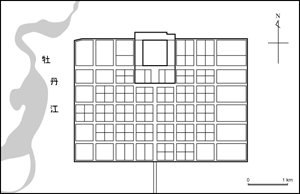
Plan of Shangjing Longquanfu restored by Noboru Ogata using the above satellite photograph.



Plan of Shangjing Longquanfu restored by Noboru Ogata using the above satellite
photograph.
As we have seen, there was also a P’o-hai Inn in Teng-chou, presumably for embassies going from and to that East Manchurian kingdom. The people of P’o-hai were Tungusic ancestors of the later Manchu Emperors of China and like the Koreans were busily engaged at this time in creating a small replica of the T’ang Empire in their far northern forests.
— E. O. Reischauer, Ennin’s Travels in T’ang China, 1955, p.280.
Ennin, a Japanese Buddhist priest, traveled in China to study Buddhism from 838 AD to 847 AD. In his travel diary, he recorded that there was a Bohai Inn in Dengzhou on the coast of Shandeng Peninsula and that a trading vessel from Bohai was anchored near the coast of the peninsula.
The Bohai (Parhae in Korean) State was a kingdom that existed from 698 AD to 926 AD in the northeastern part of today’s China. It was formed by the Tungusic people in association with the refugees from Koguryo, which had fallen in 668. It actively imported Chinese culture and political systems and boasted a high standard of civilization. At a time when it was bringing tribute to China, it also dispatched many envoys to Japan across the sea. Since records of Bohai itself have been lost, we can only glimpse its prosperity, apart from the archaeological evidence, through Chinese histories and records in Japan about its envoys. Xin-Tang-shu, a history of Tang China compiled in 1060, praised Bohai as follows.
| The king (of Bohai) sent students to the College at the Capital (of China) many times and had them study the political systems of all ages. Accordingly, it became a thriving country eastward across the sea. It had five capitals, 15 provinces and 62 counties. The Northern Capital (Shangjing), located in the old territory of the Sushen tribe, was named Longquanfu and had three counties of Long, Hu and Bo as its jurisdiction (Volume 219). | .gif) |
The following is the list of the five capitals mentioned in Xin-Tang-shu.
The Five Capitals of the Bohai State Suggested Sites Shangjing Lonquanfu (Northern Capital) Ning’an, Heilongjiang, China Zhongjing Xiandefu (Central Capital) Helong, Jilin, China Donjing Longyuanfu (Eastern Capital) Hunchun, Jilin, China Nanjing Nanhaifu (Southern Capital) Hamgyongdo, North Korea Xijing Yalufu (Western Capital) Linjiang, Jilin, China
Envoys from Bohai to Japan exchanged Chinese poems with Japanese nobles, although neither were Chinese speaking people. Some of their anthologies survived in Japan.
Shangjing Longquanfu, the capital of the Bohai State, was located at today’s Dongjingcheng near Ning’an, Heilongjiang Province of China. It is known that the ruins of the capital hold the features shared by East Asian ancient cities, namely the rectangular shape, grid patterns for streets, outstanding width of the main street, and location of the palace site in the center of the city’s north side. The above satellite photograph shows these features very clearly, indicating that Shangjing was planned in the typical style of 8th century East Asia.
By Noboru Ogata, Emeritus, Kyoto University